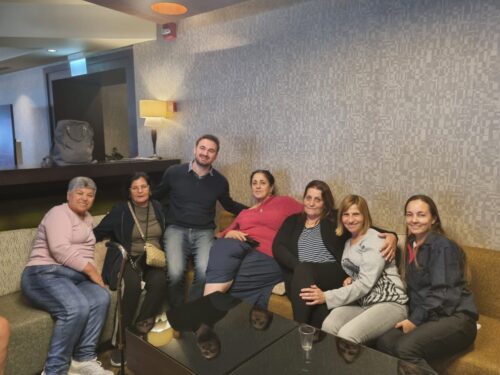I’m writing to share my recent experiences and insights from my visit to Haifa, a journey that was both important and deeply moving. My visit included solidarity visits to CJP’s partners, grantees, and community lay leaders in Haifa. I shared how the American Jewish community in Boston has been incredibly supportive of Israel, discussed the ongoing emergency relief work since Oct. 7, and also shared some insight into the rise of antisemitism in the U.S.

Witnessing the impactful work of our partners, both through the Boston-Haifa Connection and the Israel Emergency Fund, was truly inspiring. I’ve returned with numerous learnings about the trauma and resilience of the people in Israel, in some ways mirroring the resilience and leadership I’ve seen from many young Jews in America.
A Different Perspective From Inside Israel
Living in America, our view of Israel is often shaped by what is presented in the world media. However, being in Israel tells a different story. It’s a nation still grappling with the aftermath of the events of Oct. 7. I witnessed firsthand the struggles of refugees displaced by the war, the challenges faced by small businesses still recovering from shutdowns, and the deployment of employees. The daily life in Israel is defined by a continuous effort to move forward amid prevailing uncertainties. I was proud of our grantees’ dedication toward helping Israeli society recover and thrive in these challenging times.

Haifa has its own unique narrative. The city knows the reality of people being displaced—just before my arrival, a rocket was shot over Haifa, a fact not widely covered by mainstream media. As the world celebrated the new year at midnight, rocket fire across Central Israel was another stark reminder of the ongoing war. Interestingly, my GPS often malfunctioned during my stay, frequently indicating that I was in Lebanon—a measure, I learned, to misdirect GPS-guided missiles aimed at Haifa.

I had the opportunity to meet with many refugees from the northern border with Lebanon, many of whom have been living in hotels for months without an end in sight. You see children roaming the lobby or makeshift conference rooms that are now their interim living rooms. Here is a video from our grantee Dror Israel on their makeshift schools in abandoned storefronts of Haifa. Some of these refugees have been told their homes are destroyed and may never be rebuilt due to ongoing safety concerns and proximity to the border, painting a vivid picture of their prolonged hardship and the stark realities of war.
Haifa: A Beacon of Hope and Coexistence
Despite the shadows of war, there is a sense of safety and calm in Israel, perhaps more pronounced than what we experience in the U.S. Haifa stands as a shining example of what Israel aspires to be—a beacon of coexistence and hope.

During my visit, I had the opportunity to be at Haifa University on its first day of classes since the disruptions of Oct. 7. The campus was alive with energy, a melting pot of students from diverse backgrounds—Christians, Muslims, and Jews—all coming together to learn b’yachad (together). This harmonious gathering of different cultures and faiths in pursuit of education was truly inspiring.

Another highlight was my visit to our long-standing partner Parents at the Center. Here, I witnessed a remarkable “Mommy and Me” group where Russian-speaking immigrants, Arab-Israelis, Ethiopian Jews, and Haredi mothers sat together. The atmosphere was one of mutual support and understanding, transcending cultural and linguistic barriers. It was a microcosm of the peaceful coexistence that Haifa embodies and strives for.
As we continue our support and partnership, I am more committed than ever to our cause. I also want to shout from the rooftops how the future of the Jewish people, as I’ve witnessed, is indeed in good hands.



